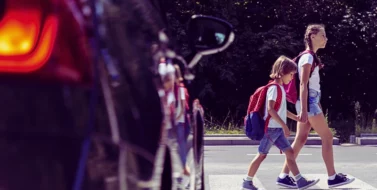Can a pedestrian sue if hit by a car? A pedestrian can sue if hit by a car in Illinois if the pedestrian is not more than 50% at fault for his or her injuries. Illinois uses the modified model of comparative negligence for personal injury cases. It allows plaintiffs (or injured pedestrians, in this case) to collect damages as long as they are not more than half responsible for their injuries. The answer to, “Can a pedestrian sue for damages if hit by a car?” goes beyond the assignment of fault, though. Other factors at play involve the statute of limitations and other potential parties to sue.
Table of Contents
When Can a Pedestrian Sue for Damages?

Bicycle & pedestrian accident attorneys help injured plaintiffs determine the answer to the question “when can a pedestrian sue for damages?” Lawyers work to estimate the allocation of fault. If they determine that you, the pedestrian, are less than 50% at fault, you may have a good case. You must be injured and have suffered compensable damages.
In trials, juries are the finders of fact and also act to apportion responsibility for the accident. Before proceeding with a case, your lawyer assesses whether you were involved in situations such as jaywalking, walking while seriously impaired by alcohol or drugs, not using a sidewalk when one was readily available, walking along a highway where pedestrians are not allowed, soliciting for donations, crossing against a crosswalk signal, or hitchhiking.
Any of these instances could reduce the amount of compensation you get or even push you over the 50 percent threshold for fault. After all, the defendant is likely to argue that you contributed to your harm by engaging in that action. However, these arguments are rarely a complete defense. They may negate the defendant’s liability somewhat, but often do not eliminate it completely. Illinois law states that drivers are required to exercise due care at all times to avoid collisions with pedestrians and bicyclists.
Right of Way in Illinois
Neither drivers nor pedestrians have absolute right of way. In Illinois, pedestrians typically have the right of way at marked crosswalks. However, they still must follow traffic signals (assuming the signals are working). When there are no signals, pedestrians’ right of way depends on where they are related to oncoming traffic. If pedestrians are more than half finished crossing the road in a crosswalk, drivers should stop and yield to them.
Drivers generally have the right of way at areas other than crosswalks. In these situations, it is incumbent upon pedestrians to yield to vehicles. However, if a car hits a walker where there is not a crosswalk, the driver could still be found to be more than 50 percent at fault. It is drivers’ responsibility to pay attention to the road.
Common Causes of Pedestrian-Car Accidents
There are many causes of pedestrian-car accidents. Some of the most common involve the following situations.
- Distracted drivers
- Impaired drivers (sleep-deprived or under the influence of alcohol or drugs)
- Speeding while driving
- Rolling stops (drivers not stopping properly and not noticing pedestrians)
- Driver inexperience
- Failure to slow down in school zones
Other causes are drivers not following traffic laws (for example, making illegal U-turns or not adhering to signage), drivers making left-hand turns without looking for pedestrians, malfunctioning traffic lights, medical events, distracted pedestrians, and unmarked crosswalks.
Distracted driving is a major contributor. It does not take much to distract someone. Phone notifications, a fly in the car, a child crying from the backseat, and being lost in thoughts are just a few of the ways.
Determining Who to Sue After a Pedestrian Accident
The driver is an obvious person to sue after a pedestrian accident, but other parties could be liable. For example, non-drivers could be responsible in construction scenarios. Your lawyers will figure out who to sue, so you can focus on your own recovery. If you sue the driver, you likely will do so through his or her insurance company.
The driver and owner of the car may not be the same person, either, so you might also end up suing the owner’s insurance company. If the drivers were on company/employers’ time or business while driving, then one avenue could be to sue the employers. You can sue for lost income, future lost income, medical expenses, long-term care, pain and suffering, loss of consortium, wrongful death, and other damages that apply.
Even if the driver or owner is uninsured or underinsured, you have options. Underinsured motorist accidents are fairly common, which is why states typically require drivers to get them. Unfortunately, when pedestrians file an uninsured/underinsured motorist claim or health insurance claims with their vehicle or health insurance company, the company may refuse to pay or make a low settlement offer. Your insurer may go seemingly overboard investigating the crash and questioning the legitimacy of your injuries. It is unfair and can be very demoralizing. Your lawyer can offer help and advice.
Construction work poses various possibilities for pedestrian injuries. For instance, falling materials can injure pedestrians. It is also common for contractors to erect signs that direct pedestrians to use a sidewalk on the other side of the street. If contractors block the view of pedestrians from seeing oncoming traffic, the contractor could be held responsible for injuries.
Road conditions and traffic control devices could also have played a role in your injuries. In these cases, the city or state government might be a responsible party.
Your lawyers evaluate the situation fully, examining if you bear any fault, what fault the driver bears, and the responsibility of any other parties.
How Long After an Accident Can a Pedestrian Sue if Hit by a Car?
Pedestrians have two years from the date of the accident to file a lawsuit against the driver and other responsible parties. A few exceptions do apply, such as if you were too disabled from the accident to sue. You may be OK waiting to sue until after you have recovered. Minors under 18 have more flexibility, too. They can wait until they turn 18 to sue.
Whatever the case, do not assume an exception might apply to your situation. It is best to get going on a personal injury case as soon as possible. Failing to file in the allowed time may affect your ability to recover damages. Talk with your lawyer about compensation soon after an accident.
If the crash killed your loved one, you may be able to get compensation for your loss. The personal representative of the decedent’s estate files the wrongful death claim for the benefit of surviving spouses or next of kin. Courts decide how to divide the payout. The two-year statute of limitations applies here, too. Chicago wrongful death attorneys can assist you with these cases.
What Are Common Pedestrian Accident Injuries?
Pedestrians are often severely injured or killed in car-walker collisions due to the direct impact of a vehicle against their unprotected bodies. In 2021, 214 pedestrians in Illinois were killed.
Common types of injuries are traumatic brain injury (TBI), spinal cord, broken bones, bone fractures, neck, internal, and soft tissue. Disfigurement or amputation can result from a driver-pedestrian collision, too.
What Should Pedestrians Do After a Car Hits Them?
The aftermath of an accident can be confusing and traumatic. It’s not always clear what to do, but the actions that pedestrians take after an accident prove critical for their health and legal case. Even if you are not hurt, you may be so shaken you cannot do a lot of the following steps yourself. If someone is with you, maybe he or she can address these matters.
The first step is to call 911 if anyone needs medical attention right away. If the police have not been called, someone should call them, so they can assess the accident and write a report. Exchange contact and insurance information with the driver. Obtain the car owner’s information if the driver is not the owner of the vehicle. At no point should you talk about who you think caused the accident, assign blame, or discuss legal aspects. The scene of an accident is not the time to do this and could harm a case eventually.
You or someone with you would ideally take pictures of the scene and your injuries, and gather the names and contact information of witnesses. Go see a doctor as soon as possible, even if you believe you do not have injuries or that they are not too bad. Many injuries manifest or get worse later. Immediate medical attention helps with documentation and cause and effect. For example, if you wait to see a doctor, the defendants could argue that something else caused your injuries. This may impact your recovery, should you take legal action.
How can a pedestrian sue for damages? The first step in filing a lawsuit is to contact a pedestrian accident lawyer at our law firm for a free consultation. Our attorneys have helped our clients recover millions in compensation.





